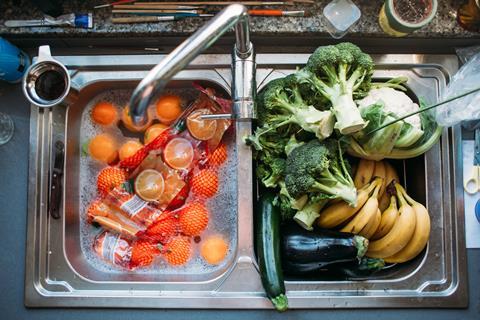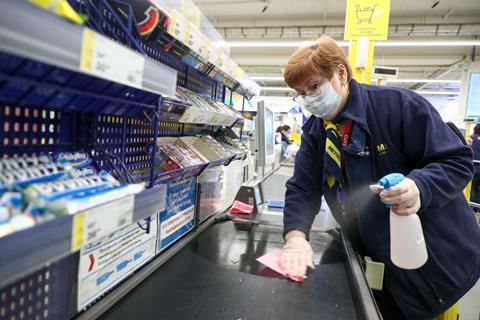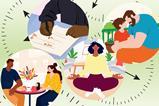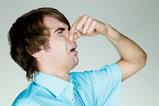Chemists investigate how long viruses remain viable on various surfaces; here’s what we know about Sars-CoV-2’s viability so far

A few weeks ago, a Michigan family doctor’s video explaining how to decontaminate your groceries went viral. On the other side of the Atlantic, a Nottingham postman’s partner was encouraging people to keep their letterboxes clean to protect postal workers. Now, with more than half of the world’s population living in lockdown, most of us are taking every precaution we can to halt the spread of the virus that causes Covid-19. For some, this doesn’t just mean covering your mouth when you sneeze near the postman; it means sanitising everything that leaves or enters the house, including the shopping.
In your class
As schools across the country remain closed to the majority of students, share this article and the associated resources with your classes to help them understand some of the science behind the coronavirus pandemic. Older students can be encouraged to further research the biochemistry of viruses and discover the detail behind how they infect human cells.
Although the NHS has said it is unlikely Covid-19 is being spread by packages and food, experts at the World Health Organisation have advised washing fruit and vegetables before eating. The information we are getting seems to be conflicting. So what’s the truth?
The question here is whether the disease can be spread by touching contaminated surfaces and the answer is not as straightforward as you might hope. ‘It’s quite technically difficult, experimentally,’ says Oxford University chemist Mark Moloney, to answer what might appear to be, on the face it, this simple question.
How long?
First, let’s consider what this coronavirus, or Sars-CoV-2 – one of several coronaviruses that can be lethal in humans – actually is and what happens to it when it leaves its human host. Like all viruses, coronaviruses are tiny protein-coated particles carrying genetic information that gives them the ability to replicate inside the cells of their hosts. They’re not alive in the same way that we, or even bacteria, are and when we look at how long they can survive outside the cells of other living things, the answer is usually ‘not very long’.
But how long is ‘not very long’?
Even with influenza viruses, some of the most intensely studied, it’s hard to give a straight answer. Although researchers have detected traces of flu virus RNA on surfaces for seven weeks, it doesn’t mean you can get flu from a door handle that an infected person touched more than a month ago. In fact, it’s generally thought the chance of infection drops to nearly zero within a matter of hours. When it can still pass on the disease, a virus is called ‘viable’.
So as soon as a virus hits a surface it’s on a countdown – find a host or perish.
At the molecular level, it’s more like a relief map of Switzerland
Sars-CoV-2 is just 50– 200 nanometres across, many times smaller than a red blood cell or a grain of pollen, and as Mark notes, it’s vulnerable to the environmental conditions as well as any ‘bits and pieces’ that land there. But we also need to consider the surface itself, what that looks like at the level of the virus and how it affects viability. ‘We tend to think of a surface as just being flat,’ Mark says. ‘But at the molecular level, it’s more like a relief map of Switzerland.’
Download this
Worksheet, for age ranges 14–16 and 16–18
In this series of questions, students are encouraged to look at the structure of a Sars-CoV-2 virion at an atomic level. The questions provide a suitable extension task for the biochemistry sections of 14–16 or 16–18 courses. Download the 14–16 questions as MS Word or pdf and the 16–18 questions as MS Word or pdf.
In this series of questions, students are encouraged to look at the structure of a Sars-CoV-2 virion at an atomic level. The questions provide a suitable extension task for the biochemistry sections of 14–16 or 16–18 courses. Download the 14–16 questions and the 16–18 questions as MS Word or pdf from the Education in Chemistry website: rsc.li/353Xfoz
We already know that more mountainous topographies – rougher surfaces – tend to cause viruses to break down faster, whereas on smoother surfaces they remain viable for longer. ‘Often viruses will last longer on stainless steel because of this smoothness,’ says chemical engineer Caryn Heldt, who studies virus removal and detection. ‘[The virus is] round – so if it interacts with a fairly flat surface, only a very little bit of it interacts, whereas if something round interacts with something rough, a lot more of it interacts.’ These extra interactions, she says, are what make it more likely to fall apart.
Survival rates
In the case of the new coronavirus, scientists are still studying survival on different surfaces. A paper published by German scientists in January this year looked at data from other coronaviruses, including those responsible for the 2003 Sars outbreak and Mers. They suggested these viruses could remain infectious on surfaces for up to nine days. But a more detailed picture is now emerging, with a US team publishing work specifically on the survival of Sars-CoV-2.
The researchers detected ‘viable virus’ three days after spreading it on steel and plastic surfaces, while on cardboard there was no trace of it after 24 hours. In this respect, the Sars-CoV-2 seems to behave ‘like a typical virus’, Caryn says, noting that it survived longer on the smoother surfaces. Within three days on steel and plastic, however, the amount of virus present had decreased by more than a thousand-fold.
There’s no doubt that touching a contaminated surface does carry a risk … But it’s not nearly as bad as contacting that surface directly with your mouth
It’s difficult to know how well this type of experiment represents what happens in real life, though. According to Caryn, the concentration of virus being tested is usually higher than the low concentrations we’d expect to find on surfaces in our homes or in public places. ‘So does that mean it’s likely to be an overestimate in terms of how long it takes for the virus to become unstable?’ she asks. ‘That’s a really hard question to answer. We don’t know.’

Outside the lab
Also, as Mark points out, such experiments reveal nothing about whether infection actually occurs by touching these surfaces. Research in other viruses does suggest it’s possible: in one particular study on rotavirus, volunteers became infected by touching contaminated plates and then touching their mouths, although they were twice as likely to get infected if they licked the plate. ‘So, I think there’s no doubt that touching a contaminated surface does carry a risk,’ says Mark. ‘But it’s not nearly as bad as contacting that surface directly with your mouth.’
As for sanitising your shopping, you can scrub down plastic packets in soap and water, but porous surfaces like cardboard are harder to clean – even if viruses do deteriorate faster on them. According to Caryn, some fruit and vegetables that we buy loose, like bananas, also have porous skins. The challenge is understanding how viruses behave on the huge variety of different surfaces we come into contact with every day, at the same time as considering how we can treat them. If in doubt, it’s probably easier to quarantine your cereal boxes.
More recommended resources
- To discover more about coronavirus: what it is, how it’s spread and how soap and alcohol sanitisers work against it, take a look at this article and attached resources
- Use these easily accessible infographics created by Compound Interest to find out how coronavirus can be destroyed and how tests for it work.
- Learn about the role chemists play in creating vaccines in this feature article and associated resources for the 16–18 age group.
- Help students visualise larger molecules including DNA and proteins in three dimensions using real data from the Protein Data Bank in Europe (PDBe). A full description of how to access the PDBe and associated teaching resources can be found in this teaching idea article.
- Add context with our short careers videos showing how chemistry is making a difference.
- Inspire learners and discover more ways chemists are making a difference to our world with our job profiles.
- Discover more about coronavirus – what it is, how it’s spread and how soap and alcohol sanitisers work against it – in this article, Coronavirus and handwashing, attached resources: rsc.li/2VnMnyL
- Use the Compound Interest infographics about coronavirus to find out how it can be destroyed and how tests for it work: bit.ly/2Y3RZQc
- Learn about the role chemists play in creating vaccines in the feature article, How chemists create vaccines, and associated resources for the 16–18 age group: rsc.li/3apbKo3
- Help students visualise larger molecules including DNA and proteins in three dimensions using real data from the Protein Data Bank in Europe (PDBe). Read this full description of how to access the PDBe and associated teaching resources: rsc.li/2VnJa20
Article by Hayley Bennett, a science writer based in Bristol. Resources by Catherine Smith, a teacher at Hinckley Academy and John Cleveland Sixth Form Centre in Leicestershire



















No comments yet